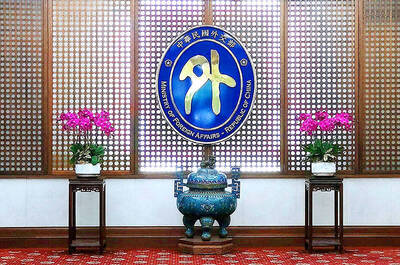Cross-strait academics called on cooperation between Taiwan and China in the compilation of literature to establish a legal basis for their respective sovereignty claims over the South China Sea — which are nearly identical — in a recently published joint research report.
The suggestion was made in the concluding chapter of a publication, the third of its kind since a group of academics began joint study on the topic three years ago, with an annual publication coming out at the end of each year.
The academics were led by Liu Fu-kuo (劉復國), a research fellow at Taiwan’s National Chengchi University’s (NCCU) Institute of International Relations, and Wu Shicun (吳士存), president of China’s National Institute for South China Sea Studies, which is affiliated with the Chinese Ministry of Foreign Affairs.
As territorial disputes in the South China Sea involving Brunei, Malaysia, the Philippines and Vietnam could evolve into legal battles, both sides of the Taiwan Strait need to have in place legal and historical evidences for their respective claims to create a strong case during discourse on the issue, they said.
They said Taiwan and China should jointly publish a report to present to the international community sufficient legal and historical proof to underpin their nearly identical claims represented by the “nine-dash line,” also known as the “U-shaped line,” that covers a large part of the South China Sea.
It is of equal importance to dig out archival materials — historical records, diplomatic documents or navigation diaries kept by law enforcement officers of the time — to represent the history of some of the islands, reefs and shoals in the region that were illegally occupied by neighboring countries before the 1970s, they said.
“This can only be achieved through cooperation because the historical archives are scattered throughout Taiwan and China,” they added.
In an article written by Yen Tieh-lin (閻鐵麟), deputy executive director of the NCCU’s MacArthur Center for Security Studies, he suggested that legal justification for the “nine-dash line” be an issue on the front burner of cross-strait cooperation in issues related to the South China Sea.
Yen said that there has been no legal justification whatsoever for the “nine-dash line” since the territory within the line was first claimed in 1947 by the then-Nationalist government in Beijing, which fled to Taiwan in 1949.
In 1993, the Taiwanese government did give the status of historic water to the water areas within the nine-dash line when it issued the “Policy Guidelines for the South China Sea,” but the policy guidelines were repealed in 2005 under the previous Democratic Progressive Party administration, Yen added.
Since the abolishment of the 1993 policy guidelines, no new policy guidelines have been introduced, even after President Ma Ying-jeou (馬英九) took office in 2008, a reflection of Taiwan’s precarious position in the South China Sea, said Lin Ting-hui (林廷輝), an associate professor at the Central Police University’s Department of Maritime Police.
Taiwan would not dare join hands with China in asserting sovereignty over the region because that would displease Southeast Asian countries and the US, which has concerns over Taiwan siding with China in the dispute, he said.
The government does not also want to risk offending China, even though it wants to seek cooperation with Southeast Asian countries, Lin said.
Moreover, the chance of Taiwan teaming up with Southeast Asian countries is low due to political constraints given these countries’ “one China policy,” Lin added.
However, instead of sticking to the current policy of inaction, Taiwan should seek to cooperate with China or with multiple Southeast Asian countries to boost its presence in the region in the fields of research and marine resources exploration and enhance its defense capabilities on Itu Aba Island (Taiping Island, 太平島) in the Spratly Islands (Nansha Islands, 南沙群島) and the Pratas Islands (Dongsha Islands, 東沙群島), which are controlled by Taiwan, Lin said.
Being in the crevice between the US and China, “Taiwan needs to play wisely to maximize its benefits in the region,” Lin said.
Except for China and countries that side with Beijing — such as Cambodia — which object to any suggestion that the sovereignty issue of the South China Sea be discussed in multilateral forums, multilateralism is favorable to most relevant ASEAN countries and the active extra-regional powers — the US, Japan, India and Australia, the joint report said.
The biggest obstacle to the inclusion of Taiwan in a multilateral mechanism lies in China’s policy to exclude Taiwan internationally, the academics said.
They suggested a more open and flexible approach from China toward Taiwan’s participation in such mechanisms, because that “would enable both sides to strengthen their leverages at the negotiating table.”
When it comes to cross-strait cooperation in this regard, it is Taiwan that needs to overcome its own “scruples in political overtone” to make it feasible, they said.
China has hoped to have Taiwan stand on its side of the dispute because that will strengthen its claim of sovereignty over Taiwan under its “one China” policy, but that aspiration can only complicate matters, they said.
Given that, both sides of the Taiwan Strait can begin cooperation in areas perceived to be less politically sensitive, such as research, anti-piracy activities, naval humanitarian operations and natural resources explorations, to build up the mutual trust needed to deal with more complex issues, they said.

The Ministry of Foreign Affairs (MOFA) yesterday voiced dissatisfaction with the Comprehensive and Progressive Agreement for Trans- Pacific Partnership (CPTPP), whose latest meeting, concluded earlier the same day, appeared not to address the country’s application. In a statement, MOFA said the CPTPP commission had "once again failed to fairly process Taiwan’s application," attributing the inaction to the bloc’s "succumbing to political pressure," without elaborating. Taiwan submitted its CPTPP application under the name "Separate Customs Territory of Taiwan, Penghu, Kinmen and Matsu" on Sept. 22, 2021 -- less than a week after China

ALIGNED THINKING: Taiwan and Japan have a mutual interest in trade, culture and engineering, and can work together for stability, Cho Jung-tai said Taiwan and Japan are two like-minded countries willing to work together to form a “safety barrier” in the Indo-Pacific region, Premier Cho Jung-tai (卓榮泰) yesterday said at the opening ceremony of the 35th Taiwan-Japan Modern Engineering and Technology Symposium in Taipei. Taiwan and Japan are close geographically and closer emotionally, he added. Citing the overflowing of a barrier lake in the Mataian River (馬太鞍溪) in September, Cho said the submersible water level sensors given by Japan during the disaster helped Taiwan monitor the lake’s water levels more accurately. Japan also provided a lot of vaccines early in the outbreak of the COVID-19 pandemic,

THE GOOD WORD: More than 100 colleges on both sides of the Pacific will work together to bring students to Taiwan so they can learn Mandarin where it is spoken A total of 102 universities from Taiwan and the US are collaborating in a push to promote Taiwan as the first-choice place to learn Mandarin, with seven Mandarin learning centers stood up in the US to train and support teachers, the Foundation for International Cooperation in Higher Education of Taiwan (FICHET) said. At the annual convention of the American Council on the Teaching of Foreign Languages held over the weekend in New Orleans, Louisiana, a Taiwan Pavilion was jointly run by 17 representative teams from the FICHET, the Overseas Community Affairs Council, the Steering Committee for the Test of Proficiency-Huayu, the

A home-style restaurant opened by a Taiwanese woman in Quezon City in Metro Manila has been featured in the first-ever Michelin Guide honoring exceptional restaurants in the Philippines. The restaurant, Fong Wei Wu (豐味屋), was one of 74 eateries to receive a “Michelin Selected” honor in the guide, while one restaurant received two Michelin stars, eight received one star and 25 were awarded a “Bib Gourmand.” The guide, which was limited to restaurants in Metro Manila and Cebu, was published on Oct. 30. In an interview, Feng Wei Wu’s owner and chef, Linda, said that as a restaurateur in her 60s, receiving an